Adler 767 - Owner's manual
- Category
- Sewing machines
- Type
- Owner's manual
This manual is also suitable for

767
Spezialnähmaschine
Betriebsanleitung
Instruction manual
Manuel d'instructions
Postfach 17 03 51, D-33703 Bielefeld • Potsdamer Straße 190, D-33719 Bielefeld
Telefon +49 (0) 5 21 / 9 25- 00 • Telefax +49 (0) 5 21 / 9 25 24 35 • www.duerkopp-adler.com
GB
D
F
Ausg. / Edition: Änderungsindex Teile-Nr./Part.-No.:
10/2008 Rev. index: 03.0 Printed in the Czech Republic 0791 767742

Alle Rechte vorbehalten.
Eigentum der Dürkopp Adler AG und urheberrechtlich geschützt. Jede, auch
auszugsweise Wiederverwendung dieser Inhalte ist verboten.
All rights reserved.
Property of the Dürkopp Adler AG and copyrighted. Reproduction or
publication of the content in any manner, without express permission of the
publisher, is prohibited.
Tous droits réservés.
Propriété de la société Dürkopp Adler AG et protégé par la loi sur le droit
d’auteur. Une copie ou reproductionpar quelque procédé que ce soit du
contenu sans accord écrite de l’auteur est interdite.
Copyright
ã 2008 - Dürkopp Adler AG

Foreword
This instruction manual is intended to help the user to become familiar
with the machine and take advantage of its application possibilities in
accordance with the recommendations.
The instruction manual contains important information on how to
operate the machine securely, properly and economically. Observation
of the instructions eliminates danger, reduces costs for repair and
down-times, and increases the reliability and life of the machine.
The instruction manual is intended to complement existing national
accident prevention and environment protection regulations.
The instruction manual must always be available at the machine/sewing
unit.
The instruction manual must be read and applied by any person that is
authorized to work on the machine/sewing unit. This means:
– Operation, including equipping, troubleshooting during the work
cycle, removing of fabric waste,
– Service (maintenance, inspection, repair) and/or
– Transport.
The user also has to assure that only authorized personnel work on the
machine.
The user is obliged to check the machine at least once per shift for
apparent damages and to immediatly report any changes (including the
performance in service), which impair the safety.
The user company must ensure that the machine is only operated in
perfect working order.
Never remove or disable any safety devices.
If safety devices need to be removed for equipping, repairing or
maintaining, the safety devices must be remounted directly after
completion of the maintenance and repair work.
Unauthorized modification of the machine rules out liability of the
manufacturer for damage resulting from this.
Observe all safety and danger recommendations on the machine/unit!
The yellow-and-black striped surfaces designate permanend danger
areas, eg danger of squashing, cutting, shearing or collision.
Besides the recommendations in this instruction manual also observe
the general safety and accident prevention regulations!

General safety instructions
The non-observance of the following safety instructions can cause
bodily injuries or damages to the machine.
1. The machine must only be commissioned in full knowledge of the
instruction book and operated by persons with appropriate training.
2. Before putting into service also read the safety rules and
instructions of the motor supplier.
3. The machine must be used only for the purpose intended. Use of
the machine without the safety devices is not permitted. Observe all
the relevant safety regulations.
4. When gauge parts are exchanged (e.g. needle, presser foot, needle
plate, feed dog and bobbin) when threading, when the workplace is
left, and during service work, the machine must be disconnected
from the mains by switching off the master switch or disconnecting
the mains plug.
5. Daily servicing work must be carried out only by appropriately
trained persons.
6. Repairs, conversion and special maintenance work must only be
carried out by technicians or persons with appropriate training.
7. For service or repair work on pneumatic systems, disconnect the
machine from the compressed air supply system (max. 7-10 bar).
Before disconnecting, reduce the pressure of the maintenance unit.
Exceptions to this are only adjustments and functions checks made
by appropriately trained technicians.
8. Work on the electrical equipment must be carried out only by
electricians or appropriately trained persons.
9. Work on parts and systems under electric current is not permitted,
except as specified in regulations DIN VDE 0105.
10. Conversion or changes to the machine must be authorized by us
and made only in adherence to all safety regulations.
11. For repairs, only replacement parts approved by us must be used.
12. Commissioning of the sewing head is prohibited until such time as
the entire sewing unit is found to comply with EC directives.
13. The line cord should be equipped with a country-specific mains
plug. This work must be carried out by appropriately trained
technicians (see paragraph 8).
It is absolutely necessary to respect the safety
instructions marked by these signs.
Danger of bodily injuries !
Please note also the general safety instructions.

Contents Page:
Preface und general safety instructions
Part 1: Operating manual Cl. 767
(Edition: 10/2008)
1. Product description .............................. 5
2. Designated use................................. 5
3. Subclasses
3.1 Optional equipment ............................... 6
4. Technical data
4.1 Subclasstechnicaldata............................ 8
5. Operation
5.1 Upper thread ................................... 10
5.2 Adjusting the thread regulator ........................ 11
5.3 Loserthread................................... 13
5.4 Changing the needle .............................. 15
5.5 Liftingsewingfeet ............................... 15
5.6 Securingthesewingfeet............................ 15
5.7 Sewing-footstroke ............................... 17
5.8 Sewing-footpressure.............................. 18
5.9 Stitch length ................................... 18
6. Keys on sewing arm .............................. 19
7. Control and operating panel
7.1 V810 Operating panel key ........................... 21
7.2 V820 Operating panel key ........................... 22
7.3 Changing parameter values .......................... 24
7.4 Directparameternumberselection...................... 24
7.5 Operator-level parameter list for EFKA controls DA82GA and 6F82FA. 25
8. Sewing ...................................... 26
9. Maintenance
9.1 Cleaning and inspection ............................ 29
9.2 Lubrication .................................... 31
GB

Contents Page:
10. Optional equipment
10.1 Residual-thread monitor RFW 13-3/RFW 13-6/RFW 13-8/RFW 13-9 . 32
10.2 2nd Stitch length STLS 13 - 2 ........................ 34
10.3 Electro-pneumatic rapid stroke adjustment HP 13 - 7 .......... 36
10.4 Upper and lower conveyor rollers SP 470 ................. 37
10.5 AutomaticloweringWTA13-2........................ 38
10.6 Additional tension FS 13 - 1 .......................... 39
10.7 Seamcenterguide............................... 41
11. Short thread trimmer
11.1 CheckEPROM-Version ............................ 43
11.2 Position of the thread-pulling knife and the counter-knife ........ 43
11.3 Adjustthethreadcuttingstitchbeforethreadcutting........... 43
11.4 Thread clamp (Thread feeding device) ................... 44
11.5 Errors,CauseandRemedy.......................... 44
The illustrations in this operating manual relate to various subclasses of the
special sewing machine !
Please bear in mind that your special sewing machine may be different from the
machine illustrated !

1. Product description
The DÜRKOPP ADLER 767 is a special sewing machine with universal applications.
·
Flat-bed double-stitch sewing machine with lower conveyor, needle transport and
alternating upper foot conveyor.
·
Subclasses available: one or two needles, with or without edge cutter and with or
without thread trimmer beneath the stitch plate.
Single-needle machines are convertible to double-needle machines.
(not 767-AE-73 / 767-AE-5-73)
·
All subclasses have device racks in the base plate for the rapid replacement of
various devices. (not 767-AE-73 / 767-AE-5-73)
·
Maximum c learance beneath lifted sewing feet: 16 mm
(with -AE and -LG max. 13 mm).
·
Stroke of alternating sewing feet adjustable with adjusting wheel by up to 7 mm.
·
Automatic non-pressurised oil-circulating lubrication with s ight glasses for oil level
and oil circulation. Integrated hook lubrication.
·
Large, two-piece vertical hook with spool-housing lifting device.
·
Oversized, two-piece vertical hook with spool-housing lifting device.
·
A safety coupling prevents the hook from being displaced or damaged if the thread
jams in the hook track.
2. Designated use
The designated use of the 767 sew ing machine is sewing light to medium-heavy
materials. Such material is generally made of textile fibres, but it may also be leather. It
is used in the clothing industry and for domestic and motor-vehicle upholstery.
This sewing machine can also be used to produce so-called technical seams. In this
case, however, the operator must assess the possible dangers which may arise (with
which DÜRKOPP ADLER AG would be happy to assist), since such applications are on
the one hand relatively unusual and, on the other, they are so varied that no single set
of criteria can c over them all. The outcome of this assessment may require appropriate
safety measures to be taken.
Generally only dry material may be sewn with this machine. The material may be no
thicker than 10 mm when compressed by the lowered sewing feet. The material may not
contain any hard objects, since if it does the machine may not be operated without an
eye-protection device. No such device is currently available.
The seam is generally produced with textile-fibre sewing thread of gauge 11/3 Ne
B
(cotton),
11/3 Nm (synthetic) or 11/4 Nm (covering yarn). Before using any other thread the possible
dangers arising must be assessed and appropriate safety measures taken if necessary.
This sewing machine m ay be set up and operated only in dry, well-maintained premises.
If the sewing machine is used in other premises which are not dry and well-maintained it
may be necessary to take further precautions (which should be agreed in advance - see
EN 60204-31: 1999).
As manufacturers of industrial machinery we proceed on the assumption that personnel
who work on our products will have received training at least sufficient to acquaint them
with all normal operations and with any hazards which these may involve.
5
GB

3. Subclasses
The following table lists the features of the various subclasses.
Subclass Material Double- Hook Thread Edge Edger
Needle Left Trimmer Cutter
Legend: M = medium-heavy material / x = standard / - = not available
3.1 Optional equipment
The following optional equipment can be supplied for the 767:
RAP 13-2 *) Electro-pneumatic stitch locking and sewing-foot lift, pedal-operated.
RAP 13-4 Electro-pneumatic stitch locking and sewing-foot lift, pedal-operated.
RAP 13-6 **) Electro-pneumatic stitch locking and sewing-foot lift, pedal-operated.
RAP 13-6 ****)Electro-pneumatic stitch locking and sewing-foot lift, pedal-operated.
RAP 13-7 ***) Electro-pneumatic stitch locking and sewing-foot lift, pedal-operated.
FLP 13-2 Electro-pneumatic sewing-foot lift, pedal-operated.
NK 13-1 Pneumatic needle cooling, pedal-operated.
NP 13-4 Electro-pneumatic needle-retraction device for maximum clearance
beneath s ewing feet when lifted.
HP 13-7****) Electro-pneumatic rapid stroke adjustment by knee switch.
SP 470 Roller feed device, with adjustable upper and lower conveyor rollers.
WTA 13-2 Automatic lowering for upper conveyor roller.
LR 13-4 Light barrier for automatic triggering of RAP at end of thread.
KNS 2 Knee switch for triggering manual reverse sewing.
WE 3 Maintenance unit.
WE 6 Maintenance unit for pneumatic optional equipment.
RFW 13-3 Residual-thread monitor bobbin thread.
RFW 13-8 Residual-thread monitor bobbin thread (KFA).
RFW 13-9 Residual-thread monito r bobbin thread (oversized hook).
STLS 13-2 2nd Stitch length.
FS 13-1 Additional tension.
N800 005611 Seam center guide.
*) **) ***) ****) = Integrated for the subclasses
6
-73 M - - - - -
-AE-73 M - x - x x
-AE-5-73 M - x - x x
-FA-73 M - - x - -
-LG-73 M - x - - x
- FA - 273 M x - x - -
- FA S - 473 ***) M x - x - -
- 373 M - - - - -
- FA - 373 *) M - - x - -
-KFA-373**) M - - x - -
- KFA - 573 ****) M - - x - -
- FAS - 373 ***) M - - x - -
- FAS - 573 ***) M - - x - -
- VF - 373 M - x x x -
- VF - 573 M - x x x -

4. Technical data
Rated v oltage: 3 ~ 400 V, 50 Hz
1 ~ 230 V, 50/60 Hz
Dimensions: (H x W x D) 1570 x 500 x 1050 mm
Weight: approx. 56 kg (machine head only)
Working height: 790 mm (ex works)
Noise: work-place-related emission value
in accordance with DIN 45635-48-A-1-KL2
767 - FA - 373 Lc = 83 dB (A)
- 373
stitch length: 5 mm sewing-foot stroke: 1.5 mm stitch rate: 3 000 min
-1
material: G1 DIN 23328 4-layer
767 - FA - 373 Lc = 83 dB (A)
- 373
stitch length: 7.2 mm sewing-foot stroke: 5.6 mm stitch rate: 2 000min
-1
material: 2-ply Skai 1.6 mm 900 g/m
2
DIN 53352
767 - FAS - 473 Lc = 85 dB (A)
767 - FA - 273
stitch length: 5 mm sewing-foot stroke: 1.6 mm stitch rate: 2 700 min
-1
- 273 needle distance: 8 mm
material: G1 DIN 23328 3-layer
767 - FAS - 473 Lc = 84 dB (A)
767 - FA - 273 stitch length: 6 mm sewing-foot stroke: 5.6 mm stitch rate: 2 000 min
-1
- 273 needle distance: 8 mm
material: 2-ply Skai 1.6 mm 900 g/m
2
DIN 53352
767 - LG - 73 Lc = 83 dB (A)
stitch length: 6 mm sewing-foot stroke: 3.5 mm stitch rate: 2 800 min-
1
material: upholstery fabric faced both sides 435 g/m
2
767 - VF - 573 Lc = 85 dB (A)
767 - VF - 373 stitch length: 6 mm sewing-foot stroke: 3.5 mm stitch rate: 2 800 min
-1
material: upholstery fabric faced both sides 435 g/m
2
767 - AE - 5 - 73 Lc = 84 dB (A)
767 - AE - 73 stitch length: 6 mm sewing-foot stroke: 3.5 mm stitch rate: 2 800 min
-1
material: upholstery fabric faced both sides 435 g/m
2
767 - FAS - 373 Lc = 83 dB (A)
stitch length: 5 mm sewing-foot stroke: 1.5mm stitch rate: 3 000 min
-1
material: G1 DIN 23328 4-layer
767 - FAS - 373 Lc = 83 dB (A)
stitch length: 7.2mm sewing-foot stroke: 5.6mm stitch rate: 2 000min
-1
material: 2-ply Skai 1.6 mm 900 g/m
2
DIN 53352
767 - FAS - 573 Lc = 83 dB (A)
stitch length: 5 mm sewing-foot stroke: 1.6 mm stitch rate: 2 500 min
-1
material: G1 DIN 23328 4-layer
767 - FAS - 573 Lc = 80 dB (A)
stitch length: 7.2mm sewing-foot stroke: 5.6mm stitch rate: 1500 min
-1
material: 2-ply Skai 1.6 mm 900 g/m
2
DIN 53352
767 - KFA - 373 Lc = 83 dB (A)
- 573
stitch length: 5 mm sewing-foot stroke: 1.6 mm stitch rate: 2 500 min
-1
material: G1 DIN 23328 4-layer
767 - KFA - 373 Lc = 80 dB (A)
- 573
stitch length: 7.2mm sewing-foot stroke: 5.6mm/ stitch rate: 1 500 min
-1
material: 2-ply Skai 1.6 mm 900 g/m
2
DIN 53352
7
GB

4.1 Subclass technical data
Subclass 767
stitch rate:
-max. [min
-1
]
-exworks [min
-1
]
stitch length:
- forwards [mm]
- backwards [mm]
stroke height of alter-
nating s ewing feet:
- max. [mm]
- ex works [mm]
needle s ystem:
needle thickness:
(depending on E no.)
sewing-thread thicknesses:
a) cotton [NeB]
b) synthetic
sewing yarn [Nm]
c) covering yarn [Nm]
max. spool
capacity with
synthetic yarn ca. [m]
needle width/needle distance
(depending on sewing device
and E no.) [mm]
max. clearance
beneath s ewing feet:
- sewing [mm]
- lifted [mm]
handwheel belt groove
central Ø [mm]
operating pressure [bar]
air consumption [NL]
8
-73 -FA- 73 -FAS-473 -FA-273 -LG-73
-373 -FA-373 -273
3200 3500 3200 3500 3200
3200 3200 3200 3200 3000
99999
99999
77777
1-6 1-6 1-6 1-6 1-6
134-35 134-35 134-35 134-35 134-35
110-140 110-140 90-110 90-110 110-140
110-140 110-140 110-140
24 / 3 24 / 3 24 / 3 24 / 3 24 / 3
30 / 3 30 / 3 30 / 3 30 / 3 30 / 3
30 / 3 30 / 3 30 / 3 30 / 3 30 / 3
35 35 56 35 35
- - 4-30 4 - 36 -
10 10 10 10 10
16 9 (16) 9 (16) 9 (16) 13
80 80 80 80 80
66666
0,7 0,7 0,7 0,7 0,7

Subclass
stitch rate:
-max. [min
-1
]
-exworks [min
-1
]
stitch length:
- forwards [mm]
- backwards [mm]
stroke height of alter-
nating s ewing feet:
- max. [mm]
- ex works [mm]
needle s ystem:
needle thickness: [Nm]
(depending on E no.)
thread thicknesses:
a) cotton [NeB]
b) synthetic
sewing yarn [Nm]
c) covering yarn [Nm]
max. spool
capacity with
synthetic yarn ca. [m]
needle width/needle distance
(depending on sewing device
and E no.) [mm]
max. clearance
beneath s ewing feet:
- sewing [mm]
- lifted [mm]
handwheel belt groove
central Ø [mm]
operating pressure [bar]
air consumption [NL]
9
GB
-VF-573 -AE-5-73 -KFA-373 -FAS-373 -FAS-573
-VF-373 -AE-73 -573
3000 2800 3500 3500 3200
2800 2800 3200 3200 3200
99999
99999
77777
1-6 1,6-7 1,5-6 1-6 1-6
134-35 134-35 134-35 134-35 134 - 35
110-140 110-140 110-140 110-140 110-140
24 / 3 24 / 3 24 / 3 24 / 3 24 / 3
30 / 3 30 / 3 30 / 3 30 / 3 30 / 3
30 / 3 30 / 3 30 / 3 30 / 3 30 / 3
35 35 35 35 56
-----
10 10 10 10 10
9 (16) 13 9 (15) 9 (16) 9 (16)
80 80 80 80 80
66666
0,7 0,7 0,7 0,7 0,7

5. Operation
5.1 Upper thread
Caution! Danger of injury!
Turn off main switch!
The upper thread may only be threaded with the sewing
machine s witched off.
Threading upper thread (needle thread)
–
Place the thread spool on its column and pass the thread through the guide eyelets
of the take-up arm.
–
Pass the thread through guide 7 and anti-clockwise round pre-tensioner 8. Pass
thread once more through guide 7.
–
Pass the thread round guide 11 and anti-clockwise round main tensioner 10. Pass
the thread clockwise round main tensioner 12.
10
7
8
9
10
11
12
1
2
3
4
5
6
14
15
+
-
13

–
Pass the thread clockwise round tension unit 4, past thread-tensioning spring 3 and
through guide 2.
–
Pass the thread through thread lever 1 and through guides 2, 5 and 6.
–
Pass the thread through the needle, pull a few centimetres of thread through and
cutitoff.
Threading the upper thread (2-needle machines)
Sewing machines with 2 needles are threaded similarly to single-needle m achines.
The differences can be seen in the illustration.
The thread-tensioning unit 13 is a double unit and can thus be used on both 1 and
2-needle machines.
Adjusting the upper-thread tensioner
Tension should be as low as possible. The cross-over point should be in the centre of
the material.
–
Adjusting the pre-tensioner 8.
The pre-tension should be set lower than the main tension.
–
Adjusting main tensioner (10 and 12).
Raising the upper-thread tensioner
The upper-thread tensioner is automatically raised when the thread is severed.
–
Press knob 9.
Die upper-thread tensioner remains in the raised position for as long as the knob is
held down.
5.2 Adjusting the thread regulator
The thread regulator 14 regulates the amount of needle thread necessary for stitch
formation.
The s etting depends on the following factors: - material thickness
- yarn characteristics
- stitch length
A properly-adjusted thread regulator ensures an ideal sewing result at a minimum
needle-thread tension.
At the correct setting the needle-thread loop must slide at low tension over the thickest
point of the shuttle.
Caution - danger of injury!
Turn off the main switch. The thread regulator may only be
adjusted with the sewing machine switched off.
–
Undo both screws 15.
–
Move the thread regulator 14.
The thread regulator is fitted with slots for this purpose.
Moving in the “+” direction increases the quantity of needle thread.
Moving in the “-” direction reduces the quantity of needle thread.
–
Tighten screws 15.
11
GB

12
1
2
3
4
5
6
7
891011

5.3 Lower thread
Look out! Danger of injury!
Turn off main switch!
The l ower thread may only be threaded with the sewing
machine s witched off.
Threading the lower thread (hook thread)
–
Place the thread spool on its column.
–
Pass the lower thread through the thread guide on the take-up arm and alternately
through the guide of the pre-tensioner 1.
–
Pass the thread anti-clockwise round tensioner 1 and once more through the thread
guide.
–
Carefully wind a few turns of thread anti-clockwise onto the spool by hand and
place the spool on its column.
–
Swivel the bobbin winder 4 against the empty spool.
The thread is wound onto the spool during sewing.
When spool 3 is full, winding-on is halted by the bobbin-winder lever 4.
–
Adjusting tension 1.
The thread should be wound on at minimum tension.
Threading the lower thread
–
Raise flap 5 and remove the empty spool with a magnet or tweezers.
–
Insert spool 6 in such a way that when the thread is unwound from it moves in the
opposite direction to the hook.
–
Pass the thread through slit 7 and below spring 10.
–
Pass the thread through slit 8 and pull about 3 cm through.
–
Close flap 5 and pass the thread through the flap’s guide 9.
Adjusting the low er-thread tension
The l ower-thread tension should be set in accordance with the type of seam required.
Adjust the tension with screw 11.
Fig. a: correct thread interlacing in the centre of
the m aterial
Fig. b: needle-thread tension too low
or looper-thread tension too great
Fig. c: needle-thread tension too great
or looper-thread tension too low
13
GB

14
1
2
3

5.4 Changing the needle
Look out! Danger of injury!
Turn off main switch!
The needle may only be threaded with the sewing machine
switched off.
–
Turn the handwheel until the needle bar has reached its uppermost position.
–
Undo screw 1.
–
Remove needle.
–
Insert the new needle with its throat towards the hook and push it up as far as it will
go.
–
Tighten screw 1.
IMPORTANT !
If a needle of a different thickness is fitted the settings must
be altered as specified in the service manual.
Otherwise a thinner needle may cause missed stitches or damage to the thread, while a
thicker needle may damage the tip of the hook or the needle itself.
5.5 Lifting sewing feet
Depending on the machine version the sewing feet can be raised mechanically or
pneumatically.
Mechanical
–
Operate k nee lever 2.
Pneumatic (FLP or RAP required)
–
Pull pedal half-way back.
5.6 Securing the sewing feet
Once they have been raised, either mechanically or pneumatically, the sewing feet can
be secured in the raised position with lever 3.
–
Swivel lever 3 downwards.
The s ewing feet are secured in the raised position.
–
Swivel lever 3 upwards.
They are now released.
15
GB

16
1
2

5.7 Sewing-foot stroke
The height of the sewing-foot stroke is set with adjusting wheel 1.
Machines without FA (w ithout Thread Trimmer)
On these machines the speed of rotation is not checked.
Please c omply with the note and table below.
Machines w ith FA (with Thread Trimmer)
The s ewing-foot stroke and stitch rate are interdependent. A potentiometer i s linked
mechanically with the adjusting wheel 1. By means of this potentiometer the control unit
detects which foot-stroke has been set and restricts the speed accordingly.
Machines with HP 13 - 7 (Speedomat)
The maximum stroke can be activated while sewing is in progress with the knee switch 2.
Like machines with FA, these machines also have a potentiometer.
Adjusting the sew ing-foot stroke
–
Set adjusting wheel 1. Min. , A , B , C , D , E , F , max.
min. = minimum stroke
max. = maximum stroke
NOTE
In order to ensure maximum durability and safety in operation, the maximum stitch rates
given i n the table below should not be exceeded.
Stitch-length range Adjusting Subclass Max. stitch rate
mm wheel item stitches/min
(mm foot stroke)
0 - 6 min. - B - 373 / - 273 3 000
(up to 2 mm) -VF-373 / VF-573 3 000
-AE-73 / AE-5-73 2 800
-FAS-473 3 200
-FAS-573 3 200
-all others 3 200 (3 500)
1)
C - D -VF-373 / VF-573 2 500
(2 - 5 mm) -AE 73 / VF-5-73 2 300
-all others 2 700 (3 000)
1)
E - max all 2 000
(5 - 7 mm)
6 - 9 min - max all 2 000
(1 - 7 mm)
1)
On machines with the speedomat HP 13 - 7 the stitch rate may be increased by
about 300 stitches/min to the figures in brackets.
The HP 13 - 7 is described in detail on page 36.
17
GB

5.8 Sewing-foot pressure
The required sewing-foot pressure is set with rotary knob 1.
–
to increase sewing-foot pressure = turn knob 1 clockwise
to decrease sewing-foot pressure = turn k nob 1 anti-clockwise.
5.9 Stitch length
The required stitch length is set with rotary knob 2.
–
to increase stitch length = turn knob 2 clockwise
to decrease stitch length = turn knob 2 anti-clockwise.
5.9.1 2nd Stitch length
The following subclasses are equipped with the 2nd stitch length: 767-FAS-373-RAP-HP,
767-FAS-573-RAP-HP, 767-KFA-373-RAP-HP, 767-KFA-573-RAP-HP,
767-FAS-473-RAP-HP. Thus it is possible to activate the 2nd stitch length through one
switch.
Use the setting wheels 3 and 5 to set both stitch length.
–
Set the longer stitch length with the upper setting wheel 3.
–
Set the shorter stitch length with the lower setting wheel 5.
Altering the shorter s titch length will be easier if the longer stitch length is activated
(LED 7 on) beforehand.
Attention !
The s titch length adjusted at the lower setting wheel 5 must never be greater than that
adjusted at the upper setting wheel 3.
–
With the switch 4 you can change over from one stitch length to the other. When
the LED 7 is on, the longer stitch length is active. When the LED 3 is off, the
shorter stitch length is active.
18
14 2 3 5
Page is loading ...
Page is loading ...
Page is loading ...
Page is loading ...
Page is loading ...
Page is loading ...
Page is loading ...
Page is loading ...
Page is loading ...
Page is loading ...
Page is loading ...
Page is loading ...
Page is loading ...
Page is loading ...
Page is loading ...
Page is loading ...
Page is loading ...
Page is loading ...
Page is loading ...
Page is loading ...
Page is loading ...
Page is loading ...
Page is loading ...
Page is loading ...
Page is loading ...
Page is loading ...
-
 1
1
-
 2
2
-
 3
3
-
 4
4
-
 5
5
-
 6
6
-
 7
7
-
 8
8
-
 9
9
-
 10
10
-
 11
11
-
 12
12
-
 13
13
-
 14
14
-
 15
15
-
 16
16
-
 17
17
-
 18
18
-
 19
19
-
 20
20
-
 21
21
-
 22
22
-
 23
23
-
 24
24
-
 25
25
-
 26
26
-
 27
27
-
 28
28
-
 29
29
-
 30
30
-
 31
31
-
 32
32
-
 33
33
-
 34
34
-
 35
35
-
 36
36
-
 37
37
-
 38
38
-
 39
39
-
 40
40
-
 41
41
-
 42
42
-
 43
43
-
 44
44
-
 45
45
-
 46
46
Adler 767 - Owner's manual
- Category
- Sewing machines
- Type
- Owner's manual
- This manual is also suitable for
Ask a question and I''ll find the answer in the document
Finding information in a document is now easier with AI
Other documents
-
 Duerkopp Adler 267_valid_till_March_2016 User manual
Duerkopp Adler 267_valid_till_March_2016 User manual
-
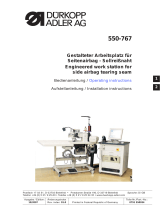 Duerkopp Adler 550-767 Owner's manual
Duerkopp Adler 550-767 Owner's manual
-
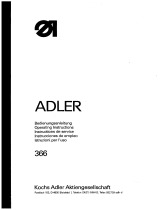 Duerkopp Adler 366 Operating instructions
Duerkopp Adler 366 Operating instructions
-
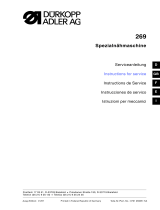 Duerkopp Adler 269_valid_till_May_2017 User manual
Duerkopp Adler 269_valid_till_May_2017 User manual
-
 Duerkopp Adler 550-16-26 Installation guide
Duerkopp Adler 550-16-26 Installation guide
-
 Duerkopp Adler 291 Operating instructions
Duerkopp Adler 291 Operating instructions
-
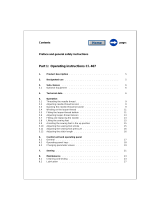 Duerkopp Adler 467-180 Operating instructions
Duerkopp Adler 467-180 Operating instructions
-
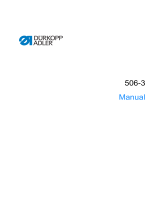 Duerkopp Adler 506-3 Operating instructions
Duerkopp Adler 506-3 Operating instructions
-
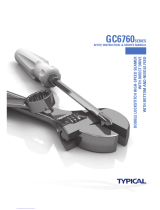 typical GC6760 SERIES Setup, Instruction & Service Manual
typical GC6760 SERIES Setup, Instruction & Service Manual
-
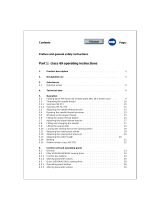 Duerkopp Adler 69_valid_till_october_2019 Owner's manual
Duerkopp Adler 69_valid_till_october_2019 Owner's manual























































